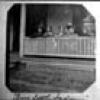Advanced Search
Fans fill the stands at Memorial Stadium. The first Shrine Bowl game pits the best high school players from North and South Carolina against each other in what will become an annual football rivalry.
Many Charlotte-Mecklenburg students must endure long bus rides to faraway schools. Even people who support busing to achieve integration are frustrated. Slowly, blacks and whites begin to talk to each other constructively and ask questions. What does or doesn't work?
November 22, 1963 - Bullets hit the car carrying John F. Kennedy in Dallas, Texas and kill America's 35th president. Only 46 years old, Kennedy had been a World War II Navy hero and a U.S. senator.
July 11, 1975 - It has been seven long years since Julius Chambers first filed the legal case, Swann vs. the Charlotte-Mecklenburg Board of Education. Integration has worked for one year. Judge James B.
In 1992, there were 11 employers in Mecklenburg County that had each hired 2,500 to 10,000 employees.
September 14, 1992 - Somebody had to be first, Gus Roberts said. Now, the man who was one of Charlotte's desegregation pioneers has died. In 1957, he was the first black student at all-white Central High.
This is a special project of the Public Library of Charlotte and Mecklenburg County in celebration of the Library's centennial year. It addresses a long-standing need to record and preserve the visual history of the African American Community.
January, 1971 - The auto repair shop of the father of civil rights attorney Julius Chambers is burned down.
November 1990 - Isaiah Tidwell becomes Regional Vice-President of Wachovia.
This photograph of the Friday Evening Social Club was taken about 1907. The members were schoolteachers at the Myers Street School.
LAURA M. BOOTON.
This image of the North Carolina Medical College was taken on April 10, 1916.The North Carolina Medical College was chartered in 1892 at Davidson College. The upper graduates moved to Charlotte in 1903 because of the new Presbyterian Hospital.
Dormitory room at Elizabeth College, caption reads, `No. 86 Booger Alley.`Elizabeth College was located on Hawthorne Road. It opened in 1896. This popular school for girls remained in Charlotte until 1915. The main building is now used by Presbyterian Hospital.
Young student or nurse posing with a hot water bottle. Caption reads, `Ready for Business.`Elizabeth College was located on Hawthorne Road. It opened in 1896. This popular school for girls remained in Charlotte until 1915. The main building is now used by Presbyterian Hospital.
Part of Elizabeth College's campus known as `the Midway` during the winter of 1902.Elizabeth College was located on Hawthorne Road. It opened in 1896. This popular school for girls remained in Charlotte until 1915. The main building is now used by Presbyterian Hospital.
Five Elizabeth College students pose under road signs that read Matthews - Providence 10 (miles) - 25 Monroe - 6 Sharon. The caption reads: Tired of livin!Elizabeth College was located on Hawthorne Road. It opened in 1896. This popular school for girls remained in Charlotte until 1915.
Elizabeth College students posing with one woman lookjng down a hole, while three others look on. The caption reads, At the spring in the grove. Elizabeth College was located on Hawthorne Road. It opened in 1896. This popular school for girls remained in Charlotte until 1915.
Marie Matson and friend on bed in dormitory room at Elizabeth College.Elizabeth College was located on Hawthorne Road. It opened in 1896. This popular school for girls remained in Charlotte until 1915. The main building is now used by Presbyterian Hospital.
Elizabeth College students posing above the caption`Five Little Indians.` Elizabeth College was located on Hawthorne Road. It opened in 1896. This popular school for girls remained in Charlotte until 1915. The main building is now used by Presbyterian Hospital.
Image of two Elizabeth College students possibly walking near the Square. The caption reads, `The Trysting Place.`Elizabeth College was located on Hawthorne Road. It opened in 1896. This popular school for girls remained in Charlotte until 1915.










